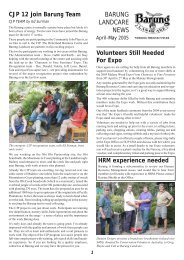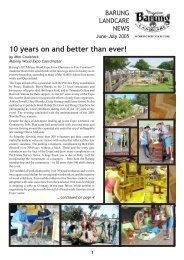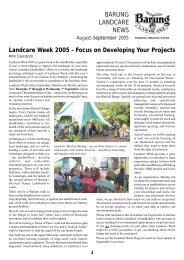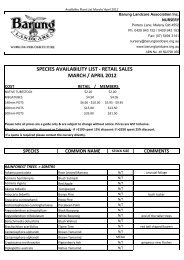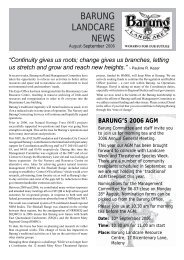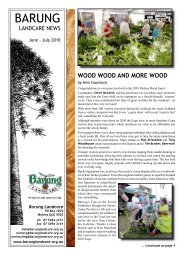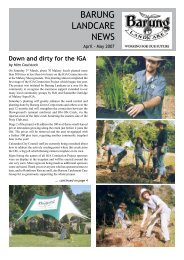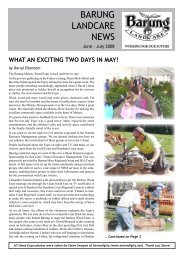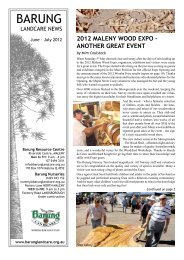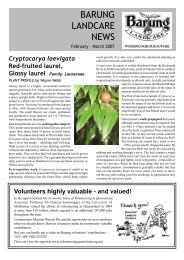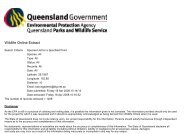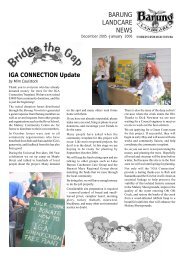October/November 2012 - Barung Landcare
October/November 2012 - Barung Landcare
October/November 2012 - Barung Landcare
Create successful ePaper yourself
Turn your PDF publications into a flip-book with our unique Google optimized e-Paper software.
BARUNG<br />
LANDCARE NEWS<br />
<strong>October</strong> -<br />
<strong>November</strong><br />
<strong>2012</strong><br />
<strong>Barung</strong> Resource Centre<br />
Riverside Centre, MALENY<br />
Mon to Fri: 9 am - 4 pm<br />
07 5494 3151<br />
info@barunglandcare.org.au<br />
PO Box 1074 Maleny Q 4552<br />
<strong>Barung</strong> Nurseries<br />
0429 943 152<br />
nursery@barunglandcare.org.au<br />
Porters Lane NORTH MALENY<br />
WED to FRI: 9 am to 3 pm<br />
Forestry Road LANDSBOROUGH<br />
Opening 3 <strong>November</strong> <strong>2012</strong><br />
www.barunglandcare.org.au<br />
TREES, BIRDS & OTHER CRITTURS<br />
- <strong>Landcare</strong> Week <strong>2012</strong><br />
by Jonathan Waites<br />
<strong>Barung</strong> celebrated <strong>Landcare</strong> Week (3–9 September) with several well-attended<br />
workshops covering a range of fauna (birds, small mammals, reptiles and amphibians)<br />
and flora (rainforest tree identification, tree-planting and maintenance). Two<br />
of the workshops were made possible through the Engaging Community Stage 2<br />
Community Action Grant funding we received from the Federal Government’s<br />
Caring for Our Country initiative.<br />
The week kicked off with Little Critturs in Your Backyard, run by Susie Duncan<br />
and Tony Bright in Susie’s suitably messy back (and front) yard.<br />
After a chat about participants’ personal experiences with critturs (little and not<br />
so little) and habitat creation in their own backyards (over coffee, tea and bun on<br />
the verandah), everyone strolled through the garden where Susie, Tony and Barry<br />
Traill brought pertinent aspects to our attention and introduced us to the diversity<br />
of inhabitants in their ponds and mulch piles.<br />
One participant was so inspired she went home and created a frog pond that very<br />
afternoon which now has a frog in residence (calling desperately for a mate).<br />
This was followed by the Rainforest Tree ID workshop run by well-known Sunshine<br />
Coast field botanist Ann Moran. Ann began with an introductory lesson<br />
in botany covering features particular to the identification of rainforest plants,<br />
demonstrating by using fresh plant specimens she had collected that morning.<br />
We then moved on to deciphering the plant keys in the rainforest identification<br />
‘bible’, the Red Book (Rainforest Trees & Shrubs, Harden, McDonald & Williams).<br />
This all seemed very straight forward until we had to identify the remaining plant<br />
specimens supplied by Wayne from the <strong>Barung</strong> Nursery.<br />
Plants are tricksy; they don’t always line up just like their namesakes in the book<br />
– at least that’s what I have concluded. I guess it takes practice.<br />
A third workshop, funded by another Community Action Grant – Maleny Community<br />
Precinct Biodiversity Monitoring and Community Engagement, was entitled<br />
Birding Basics. Eric Anderson, keen birder and <strong>Barung</strong> <strong>Landcare</strong> president, took<br />
us through the basics of choosing binoculars suited to the generalist bird watcher<br />
Continued on page 2<br />
Some of the crowd at the ‘Little Critturs in your Backyard’ workshop,<br />
as Tony Bright pointed out the benefits of the small urban backyard<br />
pond for frogs and others beasties.
MONITORING OPPORTUNITIES ON THE PRECINCT<br />
by Matt Bateman, <strong>Barung</strong> Contracting<br />
The Maleny Community Precinct Biodiversity Monitoring<br />
and Community Engagement project: What a<br />
mouthful!<br />
In simpler terms, this is a program to work out what<br />
plants and animals are on the Maleny Community<br />
Precinct and how these change over time. It’s also<br />
a program to train and educate people how to carry<br />
out this monitoring and have a lot of fun in doing so.<br />
The Maleny Community Precinct is 126 ha of<br />
ex-dairy farmland that is being transformed into a<br />
multi-use community area. The area will incorporate<br />
the Unity water treatment wetlands and forest. This<br />
situation presents a great opportunity for monitoring<br />
and managing the interactions between the existing<br />
environment and the proposed land uses and also<br />
the rehabilitation works that will be taking place on<br />
the Precinct.<br />
To this end, <strong>Barung</strong> <strong>Landcare</strong> has gained some<br />
funding from the Federal Caring for Country Community<br />
Action Grants <strong>2012</strong>–13.In collaboration with<br />
Maleny Green Hills, Mary River Catchment Coordinating<br />
Committee and Sunshine Coast Council, we are<br />
currently designing a program to survey the existing<br />
fauna, flora and water on the precinct; set up permanent<br />
monitoring sites; and compile information that will be<br />
useful in managing these elements in the future. One<br />
of the key aims of the program is to engage and train<br />
volunteers to participate in the monitoring.<br />
We have already started looking at water quality, macroinvertebrates,<br />
frogs, fish and birds. Over the next few<br />
months <strong>Barung</strong> will be running workshops on some of<br />
these topics, so keep your eye on the <strong>Barung</strong> website<br />
for upcoming dates.<br />
<strong>Barung</strong> <strong>Landcare</strong><br />
ANNUAL GENERAL<br />
MEETING<br />
Saturday 3 rd <strong>November</strong> <strong>2012</strong><br />
at <strong>Barung</strong>’s Landsborough Nursery<br />
135 Forestry Rd, Landsborough<br />
10.30 am - Registration<br />
11.00 am - Nursery Opening<br />
& Inspection<br />
12 noon - Sausage Sizzle<br />
1:00 pm - <strong>Barung</strong> AGM<br />
Kate Brooks monitoring water on the Maleny Community Precinct.<br />
Stoney Creek<br />
frogs Litoria wilcoxi<br />
mating; the smaller<br />
male is on top.<br />
Photographed during<br />
the first frog survey<br />
on the Maleny<br />
Community Precinct<br />
in mid-<strong>October</strong><br />
<strong>2012</strong>.<br />
2<br />
<strong>Landcare</strong> Week <strong>2012</strong><br />
continued from page 1<br />
and then, most importantly, focusing said binoculars. It turned<br />
out that several participants, who had owned binoculars for a<br />
number of years, had not previously discovered this feature.<br />
Further discussion covered various methodologies for spotting<br />
birds (some are notoriously reticent about being seen) and<br />
identifying them by their calls.<br />
For those technologically up to date, there is an App for your<br />
smart phone matching bird calls with their owner’s names.<br />
For those of us who still rely on the written word and pictures,<br />
Eric suggested several field guides as well as some weightier<br />
tomes as worthy references.<br />
I would like to thank all our presenters for taking the time to<br />
share their passions with us.<br />
If you would like to attend any of<br />
these workshops in the future or<br />
other workshops you would like<br />
to see run, please contact me on<br />
0429 943 151 or the <strong>Barung</strong><br />
office on 5494 3151 with your<br />
suggestions and we’ll see what<br />
we can do.
LAUGHING KOOKABURRA<br />
BIRDS OF THE BLACKALL RANGE by Eric Anderson<br />
The Laughing Kookaburra is perhaps Australia’s best known bird,<br />
famed for its ‘laughing’ call. The Kookaburra’s laugh is actually<br />
a territorial call to warn other birds to stay away. It can be heard<br />
at any time of day, but most frequently around dawn and dusk.<br />
Kookaburras are sometimes known as the ‘bushman’s clock’.<br />
The Laughing Kookaburra is recognised as the world’s largest<br />
kingfisher. Measuring up to 46 cm from beak-tip to tail-tip, it is<br />
a stocky bird with a large head, a prominent brown eye, and a<br />
very large bill. The sexes are very similar, although the female is<br />
slightly larger and has less blue to the rump than the male. The<br />
immatures are similar to adult females, while fledglings have<br />
shorter tails and bills and their bills are black throughout.<br />
The body is white or cream-coloured and the head has a dark<br />
brown stripe running through each eye and more faintly over the<br />
top of the head. The wings and back are brown with blue spots on<br />
the wings. The tail is rusty reddish-orange with dark brown bars<br />
and white tips on the feathers. The heavy bill is black on top and<br />
bone-coloured on the bottom. The legs and feet are green grey.<br />
In eastern Queensland the distribution of the Laughing Kookaburra<br />
(right) overlaps that of the Blue-winged Kookaburra (below). This<br />
other species has a lightly streaked whitish head, lacks the dark<br />
band through the eye, and has more blue in the wings.<br />
The Laughing Kookaburra is endemic to Australia. Its distribution<br />
at the time of European settlement in Australia included only the<br />
eastern part of the mainland. Since then it has been introduced<br />
to south-west Western Australia, Tasmania, Kangaroo Island<br />
and Flinders Island. It also has been introduced to New Zealand.<br />
These birds live in woodlands and open forests, but also survive<br />
well in cleared farmland, parks and suburbia, provided there are<br />
suitable tree hollows for<br />
nesting. They are carnivorous;<br />
their diet consists<br />
mainly of various insects<br />
and other invertebrates,<br />
but also includes snakes,<br />
lizards, rodents, the odd<br />
small bird and nestlings.<br />
Kookaburras pounce from<br />
suitable perches to seize<br />
their prey. Small prey is<br />
eaten whole, but larger<br />
prey items like lizards and<br />
snakes are bashed against<br />
a tree or a rock, to kill<br />
them and soften them up<br />
before they are eaten.<br />
Kookaburras tend to live in family units. The offspring help the<br />
parents hunt and care for the next generation. The nesting season<br />
is mainly September to December when around three 46 x 36 mm<br />
faintly lustrous white eggs are laid. The nest is a bare chamber in<br />
a naturally occurring tree hollow or a burrow excavated in a treedwelling<br />
termite mound. Kookaburras are believed to pair for life.<br />
Laughing Kookaburras are a common sight in suburban gardens<br />
and urban settings, even in built-up areas, and are so accustomed to<br />
humans that they will often eat out of their hands. It is not uncommon<br />
for Kookaburras to snatch food out of people’s hands without<br />
warning, by swooping in from a distance. Like the Butcher Bird,<br />
the Kookaburra will also prey on the young of other birds, and<br />
will occasionally raid farmyards for ducklings and baby chicks.<br />
3<br />
Laughing Kookaburra [above] with the brown streak<br />
running through the eye, and Blue-winged Kookaburra<br />
[left]. [Photos: Eric Anderson]<br />
HOW DOES YOUR<br />
BACKYARD GROW?<br />
Yates and Junior <strong>Landcare</strong> launch<br />
a kids’ environmental photo and video challenge<br />
Whether it’s a farm, a suburban veggie patch or an apartment<br />
balcony herb garden, Yates and Junior <strong>Landcare</strong> are asking kids<br />
around Australia, ‘How does your backyard grow?’<br />
The <strong>2012</strong> Yates Junior <strong>Landcare</strong> Backyard Challenge is getting<br />
kids to answer this question with a short film or series of photos,<br />
allowing them to showcase the unique aspects of their local<br />
environment. The challenge is a fantastic opportunity for young<br />
people to explore and discover the amazing natural wonders in<br />
their own backyards.<br />
The challenge is open to all kids living in Australia, 8 to 16 years,<br />
who can enter as individuals, or as part of a family, school group<br />
or any other community group that involves young people.<br />
Entries close: Friday 16 <strong>November</strong><br />
More info: www.juniorlandcarechallenge.com.au
TRANSITION SEASON<br />
THE ORNAMENTAL GARDEN by Joan Dillon<br />
Traditional seasonal starting dates do not apply here. For us, this<br />
is the season when the major spring flowering is just about over<br />
but buds are appearing on the syzygiums, ground cover scaevolas<br />
are starting to flower, the faithful spreading Goodenia ovata<br />
keeps on going (I don’t think it ever stops) and some melaleucas<br />
and leptospermums are still in flower or just starting. Lomandras<br />
are promising to flower heavily so I am looking forward to their<br />
perfume wafting through the garden. Native bees seem to be<br />
attracted to them too.<br />
Given our prolonged dry spell, the ornamental garden has been<br />
a much needed standby food source for the birds. The less said<br />
about bandicoots the better, but they will disperse once we get<br />
enough rain to moisten the soil beyond the garden. It has to be<br />
admitted they have not dug too many holes in the dense established<br />
garden but they have certainly been active in<br />
the vegetable patch.<br />
The birds have been wonderful. Our entire<br />
local population appears to have been taking<br />
advantage of a ready supply of nectar and<br />
insects with constant ‘fly-by’ traffic and<br />
regular splashing in the water baths. Water<br />
is such an important feature of any garden.<br />
A range of honey-eaters, whip birds, varied<br />
trillers, assorted members of the fly catching<br />
fraternity, pigeons and many others seem to<br />
have taken up at least temporary residence.<br />
The dry gully which connects the garden to<br />
the revegetation and remnant forest has been<br />
an important safe corridor for the birds and<br />
has brought home to the human population the<br />
paramount importance of connections.<br />
Further planting has been put on hold for the<br />
time being as the water supply is monitored<br />
and temperatures rise. Established plants are,<br />
SPRING CLEANING<br />
NURSERY NOTES by Fuschia Collard<br />
This is the time of year when we can catch up on some nursery<br />
maintenance. There are no events to plan for, so that means more<br />
time for WEEDING! (‘Yippee’ I hear the volunteers say!) We have<br />
a fabulous bunch of volunteers at the moment which means we<br />
can do more hand weeding and less spraying. Thanks gang! There<br />
are a few of us with chemical sensitivity who are very grateful.<br />
We have also been preparing for storm season. This is a windy<br />
site at the best of times so all the more reason to clean up around<br />
the entrance and secure what we can for our impending summer<br />
storms. We decided to give a small tank we recently received<br />
as a donation on to the Australia Koala Foundation (AKF) who<br />
were really in need of it. Jonathan Bateman kindly delivered it to<br />
the AKF property at Oakey Creek, Gheerulla, where it has been<br />
patched up and connected and is waiting for rain.<br />
Jono B says, ‘AKF are slowly turning the 100 acre property into<br />
an educational resource where people can come and engage in<br />
a range of sustainable experiences, from bush tucker cooking to<br />
flora and fauna surveys, creative arts workshops, and practical<br />
landcare volunteering (pulling out lantana).’ We are glad the tank<br />
has been put to such good use where it will be supplying water<br />
to AKF’s hard-working volunteers.<br />
4<br />
however, putting on new growth in response to higher humidity<br />
and overnight temperatures. The hardy crow’s nest or basket ferns,<br />
the aspleniums, are looking particularly good and the beautiful<br />
Phaius ground orchid has started to flower. This one can be seen<br />
in its natural habitat (a rather rare occurrence these days) in the<br />
ephemeral wetland at the Maroochy Regional Botanic Gardens.<br />
Plants are periodically available from commercial outlets but it is<br />
easy to propagate and well worth establishing in a pot for future<br />
distribution to the garden in a free draining soil or mix.<br />
As has previously been suggested, if we don’t grow these plants,<br />
we will lose them and some have already become extinct in the<br />
wild, or the populations are so low in numbers that the genetic<br />
diversity to enable adaptation to climate change is no longer there.<br />
And on that note, does anyone have viable seed of Lomandra<br />
multiflora? It’s not considered at risk but is a beautiful species not<br />
in general cultivation and therefore not easy to source.<br />
Lomandra hystrix. [Photo: John Dillon]<br />
Special thanks to some of our newer hardworking<br />
volunteers:<br />
… thanks Dylan for mowing and whipper-snipping our site and<br />
making it look wonderful<br />
… thanks Brett for always<br />
being there to help when we ask<br />
… and a big thanks to John who<br />
has been going out of his way<br />
(on his days off) to walk down<br />
and start the pump for me while<br />
Wayne has been on holidays.<br />
Also:<br />
… a big thank you and farewell to Ray Seddon of the Richmond<br />
Birdwing Butterfly Conservation Network. Ray has graciously<br />
donated some vines to the nursery as a thank you for our support<br />
over the years. Ray and Pam Seddon are taking a well-deserved<br />
rest and going exploring our beautiful country by caravan. We<br />
wish them all the best. It has been an honour to work with you,<br />
Ray. Thank you for all you have done for the Richmond Birdwing<br />
Butterfly. Happy travels!<br />
… and thank you also to our wonderful seed collectors, as well<br />
as to Lynden Druitt for his donation of plants to the nursery.
FRESH SURROUNDINGS<br />
PRESIDENT’S REPORT by Eric Anderson<br />
The <strong>Barung</strong> Resource Centre and Office in Maleny has recently<br />
had a make-over! Thanks to our admin staff, Kellie and Den, for<br />
making the Resource Centre more attractive and accessible. This<br />
also allows us to present better displays in our shop front window<br />
as evidenced by our special feature on the Glossy Black-Cockatoo<br />
for Endangered Species Day on 6th September.<br />
<strong>Barung</strong> was again a sponsor at the Lions Welcome Dinner for<br />
new residents to the Blackall Range. <strong>Barung</strong> and many other<br />
Community Groups set up small information stands to let new<br />
residents know about the services available in our community.<br />
Additionally <strong>Barung</strong> provided a decoration of native plants, as<br />
tube stock, on each table and donated these plants to the new<br />
residents. We thank the Lions for this great service they provide<br />
to the community on the Range.<br />
Engaging <strong>Barung</strong> members<br />
In the coming year we are hoping to run a regular monthly event,<br />
such as a workshop or information session of some kind, to<br />
increase our engagement with members. This will be in addition<br />
to the workshops we currently run under our various projects.<br />
by Raine See<br />
Imagine 190 glossy black cockatoos soaring down a green bank searching<br />
for a grove of she-oaks to munch on! This was the scene local artist and<br />
filmmaker, Christine Elcoate, presented to the children at Mapleton State<br />
School recently as she immersed them in the culture of the glossy black<br />
cockatoo for her latest film, ‘The Flight of the Glossy Black-Cockatoo’.<br />
Local bird specialist and <strong>Barung</strong> president, Eric Anderson, talked about<br />
the plight of the Glossy Black and its endangered status.<br />
As part of the Creating Community ‘art4place’ initiative, Christine also<br />
took the plight of the glossy black to the community during the school<br />
holidays. Local and visiting children made masks and painted wings and<br />
flew off in search of she-oaks in Russell Park at Montville. They found<br />
the perfect grove of she-oaks which had been planted three years ago by children from Montville State School.<br />
Keep an eye out for Christine’s film. The beautiful painting of the juvenile, the male and the female Glossy Blacks was painted by Jim<br />
Cox, who assisted Christine in Russell Park. Jim kindly donated the painting to Eric who will use it to spread the word about the plight<br />
of the Glossy Black-cockatoo to the community.<br />
5<br />
This leads me into thanking Jonathan Waites for organising, and<br />
the conveners for running, a number of successful ‘workshops’<br />
during <strong>Landcare</strong> week in early September, on which Jonathan<br />
reports on page 1 of this <strong>Barung</strong> News.<br />
<strong>Barung</strong>’s Annual General Meeting<br />
Please note that our AGM is on Saturday 3rd <strong>November</strong>. The<br />
AGM will be held at our new Landsborough Nursery and will<br />
be preceded by the opening of the Nursery and a sausage sizzle,<br />
so do come along and check it out.<br />
I will be standing again for President and hope to twist the arms of<br />
the current Committee members Lin Fairlie (Vice President), Pat<br />
Fuller (Secretary), David Binstead (Treasurer), Glen Donoghoe,<br />
Diana O’Connor and Raine See to stand again.<br />
However there is room for some new faces so please consider<br />
joining the Committee during this exciting time in <strong>Barung</strong>’s<br />
development. Please contact me (5445 7965) if you are interested<br />
in joining and need more information about what is involved, or<br />
would like to suggest someone who might be approached to be<br />
a Committee member.<br />
Nomination Forms are available at the <strong>Barung</strong> Office and should<br />
be returned by Friday 19th <strong>October</strong>.<br />
THE FLIGHT OF THE GLOSSY BLACK-COCKATOO
EVENTS<br />
Friday 2 <strong>November</strong><br />
LITTLE YABBA PARK BUSHCARE<br />
Little Yabba Park, Cambroon, 8am–11am<br />
On the first Friday of each month, these bushcare group members<br />
are restoring vegetation along the banks of Little Yabba Creek.<br />
Work activities are followed by a cuppa and a short bushwalk.<br />
New members very welcome. Contact Susie on 5429 6622.<br />
Sunday 4 <strong>November</strong><br />
CAMBROON WEED VINE WORKSHOP<br />
(Cambroon landholders only)<br />
Little Yabba Park, Cambroon 9am–noon<br />
An opportunity for local landholders to learn more about the<br />
diverse wildlife and forests in the Cambroon area and the threats<br />
posed by weed vines such as Madeira Vine, Cat’s Claw and<br />
Dutchman’s Pipe. <strong>Barung</strong>’s project to control these vines locally<br />
and funding opportunities for landholders to undertake work on<br />
their properties will be discussed. Geckoes Wildlife Presentations<br />
will introduce some of the local animals. Free morning tea and<br />
Birdwing Butterfly vine for all participants. Please register with<br />
Susie on 5429 6622 or wilderness@hotkey.net.au<br />
Sunday 11 <strong>November</strong><br />
ROVING RESTORERS<br />
Burgum Rd, North Maleny, 9am–12.30pm<br />
Join us for some hand weeding, planting and a picnic by the creek<br />
at this property on a beautiful stretch of Obi Obi Ck. Morning<br />
tea provided. See below for booking and travel arrangements<br />
and what to bring.<br />
Saturday 1 December<br />
ROVING RESTORERS<br />
Broken Bridge Ck, Bellthorpe National Park<br />
8.30am-3pm<br />
Join us for a 7 km walk in Bellthorpe National Park through<br />
magnificent rainforest on Broken Bridge Ck. A small infestation<br />
of Crofton Weed on the track will require about an hour’s hand<br />
weeding. The rest of the time can be spent enjoying the birds and<br />
forest as well as swimming at a beautiful rock hole. One steep<br />
grade on the track of about 300 m. A great end-of year celebration<br />
for all you dedicated bush regenerators.<br />
More info for ROVING RESTORERS:<br />
Car pool in the public carpark at the back of the Maleny IGA<br />
carpark at 8.30 am, or travel independently or arrange to be<br />
picked up on the way (call 5429 6622 for arrangements). Bring<br />
gloves, weeding/planting tools, water, lunch, boots, long-sleeved<br />
shirt and trousers, hat, sunscreen, insect repellent and togs if you<br />
wish to swim.<br />
Please register at <strong>Barung</strong> <strong>Landcare</strong> on 5494 3151 or<br />
www.barunglandcare.org.au<br />
6<br />
CONNECTING THE<br />
CONONDALES<br />
HINTERLAND BUSH LINKS by Susie Duncan<br />
The forests of the Conondale and Blackall ranges share an<br />
amazing diversity of native plants and animals.<br />
But if you look at a satellite image on Google maps you will see<br />
that the vegetation of the Blackall Range is much more fragmented.<br />
This has a big influence on wildlife such as bandicoots and<br />
gliding possums that do not readily cross cleared country. Even<br />
birds such as fruit doves won’t fly to isolated rainforest patches<br />
so they are unable to spread rainforest seed there.<br />
For this reason Hinterland Bush Links is focused on restoring key<br />
vegetation linkages between the Blackall and Conondale ranges.<br />
That way the many plant and animal species in this region will<br />
have access to more habitat, and the decline of some species will<br />
hopefully be reversed.<br />
One such link is the Cambroon wildlife corridor between the<br />
Conondale National Park and Maleny National Park. Several<br />
landholders in this wildlife corridor are already enhancing existing<br />
vegetation along creeks, often with the assistance of Sunshine<br />
Coast Council landholder grants.<br />
Restoring vegetation often means getting on top of the weeds,<br />
particularly canopy-smothering vine weeds such as Madeira Vine<br />
and Cat’s Claw which damage remnant and regenerating bush.<br />
Another weed vine of major concern is Dutchman’s Pipe which<br />
mimics the caterpillar food plant of the threatened Richmond<br />
Birdwing Butterfly. Dutchman’s Pipe contains a toxic chemical<br />
which kills the caterpillars, limiting the recovery of the butterfly<br />
population.<br />
<strong>Barung</strong> <strong>Landcare</strong> is currently<br />
undertaking a<br />
project to control these<br />
weed vines on private<br />
and public land at Cambroon.<br />
A workshop for local<br />
landholders will be held<br />
at Little Yabba Park on<br />
4 <strong>November</strong>.<br />
This will be an opportunity<br />
to learn more about<br />
the diverse wildlife and<br />
forests of the area and<br />
how to control weed<br />
vines.<br />
Information will also<br />
be available on funding<br />
support for landholders<br />
undertaking this work.<br />
The project has been<br />
funded by Burnett<br />
Mary Regional Group<br />
through Mary River<br />
Catchment Coordinating<br />
Committee.<br />
Cat’s Claw Creeper, currently in<br />
flower, has caused environmental<br />
devastation further north in the<br />
Mary River catchment and is on<br />
the march in the Cambroon area.<br />
Connecting the landscape<br />
in the Hinterland is not just about getting vegetation back.<br />
Managing weeds is critical to creating healthy habitat that will<br />
support our wonderful biodiversity.
SUNSHINE COAST KIDS IN ACTION CONFERENCE <strong>2012</strong><br />
by Jonathan Waites<br />
The Kids in Action program promotes Kids Teaching Kids as<br />
a way of learning that supports cultural change in the way we<br />
interact with our local environment.<br />
The inaugural <strong>2012</strong> Kids in Action conference included engaging,<br />
hands-on environmental activities for students in grades 5–9. Two<br />
hundred and seventy students from 18 schools across the region<br />
participated in the event on 29th – 30th August during Australia<br />
Post Kids Teaching Kids Week.<br />
The program is funded by the Sunshine Coast Council Environment<br />
Levy and aims to inspire our future environmental leaders.<br />
At the conference young delegates taught each other about a<br />
number of conference themes including,<br />
● local ecosystems and/or specific local species<br />
● whole of catchment links, waterways and caring for local<br />
creeks<br />
● biodiversity<br />
LETTERS<br />
Dear Wayne<br />
I am writing on behalf of the Church<br />
Council of the Maleny Uniting Church to<br />
sincerely thank you and <strong>Barung</strong> for the<br />
donation of the bales of mulch to replace<br />
those stolen prior to the last Obi Obi<br />
working bee.<br />
As a church, we are trying to regenerate<br />
areas around our building, including our<br />
sections of the banks of the Obi Obi Creek.<br />
Your donation was very much appreciated.<br />
Merilyn Milton,<br />
Maleny Uniting Church Council<br />
7<br />
● climate change<br />
● engaging with the community to act local and think global<br />
● waste, recycling and resource efficiency.<br />
<strong>Barung</strong> partnered with the Richmond Birdwing Conservation<br />
Network to run an event at Cahill Scrub Bushland Reserve in<br />
Peachester. Around 100 students were given information about the<br />
Richmond Birdwing Butterfly Ornithoptera richmondia and then<br />
each planted a Richmond Birdwing Butterfly Vine Paristolochia<br />
praevenosa. One very keen group planted about three each!<br />
This event builds on a two year history of Kids Teaching Kids<br />
conferences on the Sunshine Coast in which council partners with<br />
community organisations to host the environmental project days<br />
and mentors schools in preparation for conference workshops.<br />
Kylie from the Richmond Birdwing Conservation<br />
Network discussing Richmond Birdwing Butterflies with<br />
Kids in Action participants at Cahills Scrub.<br />
Hi Matt<br />
Thank you for the environmental weed control work undertaken by your crew as<br />
part of the ongoing maintenance of the Nature Refuge on our property.<br />
As usual, your staff did a great job on the day (please pass on my thanks for their<br />
very careful and selective application of the weed control chemicals) and I can now<br />
report a significant reduction in weed numbers. In particular, the military fern which<br />
has proved so difficult to remove now appears to be dying. I am conscious that<br />
this area will require ongoing follow-up weed control measures but it is reassuring<br />
to see that we are at last making some headway with removing the military fern.<br />
I’m also pleased to report that the new native food trees your crew planted on our<br />
property late last year are generally doing well (a small percentage of the trees<br />
have not taken mainly due to dry weather).<br />
Regards, Greg Johnston
BUSHCARE IN ACTION AT<br />
THE PRECINCT<br />
by Steve Swayne, Maleny District Green Hills Fund<br />
The Friends of Obi Obi Parklands Bushcare Group has been busy<br />
undertaking regular working bees over the winter months. Many<br />
hundreds of trees have been planted in the riparian areas of Obi<br />
Obi Creek on the Maleny Community Precinct. The working<br />
bees have been organised by <strong>Barung</strong>, Green Hills and Sunshine<br />
Coast Council.<br />
The working bees will continue every month. Everyone is most<br />
welcome to come along and help out with this important reveg<br />
project.<br />
Please check the Green Hills website for dates and info:<br />
www.greenhills.org.au<br />
BIRD’S NEST FUNGI<br />
Cyathus sp.<br />
FUNGAL FORAY by Gretchen Evans<br />
You may have seen some tiny fungi if you have<br />
been using woody mulch around your plants.<br />
The fungi look like little cups (less than 8 mm in<br />
diameter) containing several disc-shaped objects<br />
that look just like eggs. These are the fruiting<br />
bodies of a fungus that lives on wood or dung.<br />
Cyanthus sp. were first recorded by a Flemish<br />
botanist in 1601.<br />
What is remarkable about this fungus is its<br />
method of spore dispersal. The ‘eggs’ contain the<br />
spores, and the ‘nests’ are actually splash cups.<br />
After rain, the ‘eggs’ have a sticky coiled thread<br />
attached to them which uncoils, flinging the eggs<br />
up into the air where they may latch onto a shrub<br />
or twig, after which the spores are released.<br />
There’s a fun Youtube video showing this<br />
method of splash dispersal called ‘Evolutionary<br />
Masterpieces: The Bird’s Nest Fungi’.<br />
BITS & PIECES<br />
Compiled by Jono Waites<br />
The War on Weeds – Eating your enemy. A short article by Graeme Sait from Nutri-<br />
Tech Solutions regarding some common herbaceous plants (weeds and natives) and<br />
the possible health benefits of including them in our diets:<br />
www.ntshealth.com.au/wellness/blog/war-on-weeds.html<br />
A book about the repercussions of coal mining in Australia – looks interesting:<br />
www.richlandwasteland.com.au<br />
RSAAnimate – Drive: Dan Pink on ‘The surprising truth about what motivates us’:<br />
www.youtube.com/watch?v=u6XAPnuFjJc&feature=player_embedded<br />
Leadership lessons from a dancing guy and the importance of first followers:<br />
www.youtube.com/watch?v=fW8amMCVAJQ<br />
A short animation that tells us what we need to keep Earth together. This is what<br />
it’s all about in less than a minute! When the link opens, click on the link under The<br />
Wombat:<br />
www.global-mindshift.org/discover/viewMeme.asp?memeid=239<br />
Cyathus striatus, a Birds Nest Fungi, in mulch in the car park at Mary<br />
Cairncross Scenic Reserve. [Photo: Fran Guard]<br />
8<br />
TED Talks<br />
Ideas Worth Spreading<br />
Go to www.ted.com and search for<br />
these remarkably thought-provoking<br />
and entertaining presentations:<br />
● Jeremy Rifkin on ‘the empathic<br />
civilization’<br />
● Nicholas Christakis: The hidden<br />
influence of social networks<br />
● James Hansen: Why I must speak<br />
out about climate change<br />
● Simon Sinek: How great leaders<br />
inspire action<br />
● Jaime Lerner: sings of the city<br />
(discovering eccentric solutions to<br />
vexing urban problems)
WHITE BOOYONG<br />
Argyrodendron trifoliolatum<br />
Family: Sterculiaceae<br />
PLANT PROFILE by Fuschia Collard<br />
Because Wayne is on holidays I thought I would have a crack<br />
at a Plant Profile for this issue of the <strong>Barung</strong> News. So here is<br />
what I have learnt about the very first plant I tubed on my return<br />
to <strong>Barung</strong>…<br />
Argyrodendron trifoliolatum is pronounced ah-ghee-row-den-dron<br />
tri-foe-lee-oh-lah-tum, depending who you talk too. (However I<br />
like to pronounce it a-‘gyro’-dendron because the seeds are like<br />
little ‘gyro’copters.)<br />
White Booyong seeds (above) and buttressed trunk<br />
Argyrodendron is from the Greek words ‘argyros’ meaning silver (below). [Photos: Peter Woodard, Wikipedia]<br />
(referring to the silvery underside of the leaflets) and ‘dendron’<br />
meaning tree. When viewed from underneath, the large canopy can actually<br />
look coppery. Trifoliolatum comes from the latin roots ‘tri’ (three) and<br />
‘foliolus’ (leaves), indicating a compound leaf made up of three leaflets.<br />
Argyrodendron trifoliolatum is a large buttressed rainforest tree that can<br />
grow to 45 metres in a rainforest or around 15 m in a garden. (I just love<br />
a big buttress tree, don’t you!) It is a commonly seen native tree growing<br />
along scrubby watercourses and in subtropical and dry rainforest from<br />
north-eastern NSW through eastern and northern Queensland up into<br />
PNG. In the warmer areas it occurs at higher altitudes.<br />
White Booyong, as it is known to us locals, grows on basaltic or alluvial<br />
soil up to 600 m in altitude. Booyong is the aboriginal name for this tree.<br />
It is also known as Brown Crowsfoot, Brown Tulip Oak, Elm, Hickory,<br />
Red Booyong, Brown Booyong and more. (Phew! and I thought I had<br />
an identity problem!)<br />
From July to September White Booyong can be seen covered in a mass<br />
of small cream bell-shaped flowers which often carpet the forest floor<br />
in winter. Fruit ripens <strong>October</strong> to January. The fruit develops as clusters<br />
of one to four separate 3 cm long silvery brown winged seeds, known<br />
as samaras. These seeds exude a sticky jelly when they’ve fallen to keep<br />
them moist. The seeds are best sewn fresh for rapid germination.<br />
The seeds are eaten by Brush-turkeys and the leaves are food for the<br />
caterpillar of the Bronze Flat Butterfly.<br />
A little (potted) competition<br />
On the ‘Noosa Native Plants’ website under ‘landscaping<br />
notes’ for this species, it is suggested White Booyong can<br />
be planted as a bushy ornamental and has potential as an<br />
indoor pot plant.<br />
I am keen to hear how it goes as a pot plant. Has anyone<br />
tried it? We have plenty in stock!<br />
Let’s try it out and<br />
whoever grows the best one in a pot<br />
wins two free tubestock.<br />
Green Nomads, A QWaLC Initiative<br />
Green Nomads is a volunteering program that links Australia’s<br />
travelling population with community natural resource management<br />
groups looking for volunteer help. Through the Green<br />
Nomads program, Grey Nomads have the opportunity to contribute<br />
to and show appreciation for the beautiful places they visit.<br />
More info: www.greennomads.com.au/index.php/about<br />
9<br />
<strong>Barung</strong> Contracting Services<br />
<strong>Barung</strong> Contracting<br />
revegetation<br />
bush regeneration<br />
bush regeneration<br />
landscape rehabilitation<br />
landscape environmental rehabilitation<br />
weed control<br />
project planning & management<br />
environmental indigenous tubestock weed control<br />
consultancy & property planning<br />
project planning & management<br />
onground conservation works<br />
indigenous tubestock<br />
consultancy coordinator 0429 & 943 property 156 planning<br />
barung landcare 07 5494 3151<br />
barunglandcare.org.au<br />
onground conservation works<br />
contracting@barunglandcare.org.au<br />
contracting services 0429 943 156<br />
barung landcare 07 5494 3151<br />
contracting@barunglandcare.org.au<br />
www.barunglandcare.org.au
EVENTS<br />
RANGE BEES GET-TOGETHERS<br />
Range Bees is a group of people concerned about the future of<br />
pollination of our food crops and natural environment. Our focus<br />
is the nurturing and management of bees – honeybees, native<br />
social stingless bees and native solitary bees.<br />
Saturday 10 <strong>November</strong>, 8 am, Crystal Waters<br />
Max and Trudi will show us how they harvest and process honey<br />
– from the hive to the jar. A chance to observe a small operation<br />
working and see equipment in action together with gaining some<br />
hands-on experience. Bring clean bee suit and sterilised tools.<br />
Saturday 8 December, 2 pm, Maleny<br />
Building nests for native solitary bees. Start collecting building<br />
materials – blocks of wood, dry stems, sand, clay etc.<br />
More info: rangebees@live.com.au or 5478 6706<br />
Saturday 10 <strong>November</strong>, noon to 8 pm<br />
Kandanga Recreation Grounds<br />
Come along and celebrate the environment and diverse lifestyles<br />
sustained by the Mary River!<br />
Festival organisers are committed to empowering the communities<br />
along the Mary River by showcasing local creativity,<br />
projects, ideas, resources, and culture that enhance and<br />
protect the unique environment of the Mary River catchment.<br />
Arts and craft stalls, a local produce market, environmental<br />
displays, food stalls, workshops, entertainment and children’s<br />
activities, in a festival atmosphere.<br />
More info: www.maryriverfestival.org.au<br />
BRUSH TURKEY ENTERPRISES<br />
Snake & Reptile Ecology & ID<br />
with Martin Fingland, Geckoes Wildlife<br />
Friday 26 <strong>October</strong>, 10 am – 3 pm<br />
It’s snake time! Snake identification, snake ecology, and some<br />
snakes to see face to face.<br />
Freshwater Stream Ecology & Water Quality<br />
with Jacqui Smythe, Maroochy Waterwatch<br />
Friday 30 <strong>November</strong>, 10 am – 3 pm<br />
An introduction to the river score system and general hydrology/<br />
geomorphology and habitat information. Samples of macroinvertebrates<br />
will be collected from which we will compile a<br />
biodiversity index score.<br />
Each workshop:<br />
Cost: $88 incl morning tea and lunch<br />
At: Brush Turkey Enterprises, 468 Reesville Road<br />
To book: education@brushturkey.com.au or 5494 3642<br />
10<br />
FUNDING<br />
BE NATURAL LANDCARE GRANTS<br />
20 grants of up to $2500 are available to support volunteer community<br />
environmental groups for projects such as local community<br />
gardens or edible gardens within community centres.<br />
Applications close: Friday 26 <strong>October</strong><br />
More info: www.landcareonline.com.au/<br />
be_natural_landcare_grant<br />
QLD GOVT BUYING KOALA HABITAT<br />
The Queensland Government is investing $26.5 million over the<br />
next 4 years toward strategic koala habitat purchase, research into<br />
disease and injury, and rescue and rehabilitation services.<br />
Expressions of interest (EOI) are sought from owners of eligible<br />
properties who are interested in selling their property for use as<br />
koala habitat. Eligible properties will be assessed competitively<br />
against criteria each year.<br />
Round 1 EOIs due: 31 <strong>October</strong> <strong>2012</strong><br />
More info: www.ehp.qld.gov.au/wildlife/koalas/<br />
strategy/koala-habitat-programs.html<br />
BARUNG RESOURCE CENTRE<br />
Shop 3, Riverside Centre, Maleny<br />
MON to FRI: 9 am – 4 pm<br />
5494 3151<br />
info@barunglandcare.org.au<br />
BARUNG NURSERIES<br />
0429 943 152<br />
nursery@barunglandcare.org.au<br />
MALENY Nursery<br />
Porters Lane, North Maleny<br />
WED to FRI: 9 am – 3 pm<br />
LANDSBOROUGH Nursery<br />
135 Forestry Road, Landsborough<br />
Official opening at the <strong>Barung</strong> AGM<br />
on Saturday 3 <strong>November</strong><br />
profitable<br />
sustainable<br />
plantation<br />
forests<br />
www.hqplantations.com.au
Karen & Richard Barnett<br />
07 5478 5585<br />
montvillecoffee.com.au<br />
info@montvillecoffee.com.au<br />
Available in local stores and online Cert. No. 4200P FLO ID 3340<br />
Montville Mist<br />
Still Spring Water<br />
1800 001 102<br />
www.montvillemist.com.au<br />
Bottled at the Source<br />
Queensland Conference<br />
& Camping Centres<br />
Inspiring the next generation<br />
with outdoor education<br />
www.qccc.com.au<br />
MAPLETON<br />
07 5456 3600<br />
9 Palm St, Maleny<br />
Award Winning design for<br />
Today’s Living with<br />
Tomorrow's Needs<br />
in mind.<br />
Independence with Flexible<br />
pported Living pons<br />
<br />
<br />
<br />
<br />
11<br />
Hanson Construction Materials<br />
Best Rates & On Time Delivery<br />
Crushed Rock, Sand, Aggregates, Gravel<br />
QUARRY: Mt Beerwah Rd, Glass House Mountains<br />
(07) 5493 0111 www.hanson.com.au<br />
Rob and Samantha Outridge<br />
* FRUIT & VEGETABLES * DELICATESSEN * MEAT *<br />
26 Maple Street, Maleny<br />
Phone: (07) 5494 2257 Fax: (07) 5494 2767<br />
BUSINESS CONTRIBUTORS<br />
Suncoast Hardwoods Lions Club Maleny<br />
Maleny Green Printery Habitat Support<br />
South East Land Repair Lapmist Pty Ltd<br />
eContent & Life Artistry Earthcarer<br />
Northey Street City Farm<br />
Ananda Marga River School<br />
Range Auto & Fuel Injection Centre<br />
SUPPORT <strong>Barung</strong> <strong>Landcare</strong><br />
through YOUR MEMBERSHIP<br />
Individual/family MEMBERSHIP $ 25 pa<br />
This entitles you to the bimonthly <strong>Barung</strong> News and two<br />
free trees from the Nursery, and enables you to support<br />
<strong>Barung</strong> <strong>Landcare</strong>’s work in preserving and enhancing<br />
the natural environment of the Blackall Range and its<br />
environs.<br />
BUSINESS SPONSOR $275 pa<br />
Business Sponsors ($275/year) are entitled to<br />
• a business card size advert in <strong>Barung</strong>’s bimonthly<br />
newsletter x 6 issues<br />
• acknowledgement of your support at <strong>Barung</strong> displays<br />
• three (3) free trees, and<br />
• membership discounts on plant purchases in the Nursery.<br />
BUSINESS CONTRIBUTOR $ 55 pa<br />
Business Contributors ($55/year) are entitled to<br />
• listing in the <strong>Barung</strong> News as a business contributor<br />
• acknowledgement of your support at <strong>Barung</strong> displays<br />
• three (3) free trees, and<br />
• membership discounts on plant purchases in the Nursery.
<strong>Barung</strong> gratefully acknowledges these organisations for<br />
their partnerships & support:<br />
BARUNG 2011/12 VOLUNTARY<br />
MANAGEMENT COMMITTEE<br />
President Eric Anderson<br />
Vice President Lin Fairlie<br />
Secretary Pat Fuller<br />
Treasurer David Binstead<br />
Committee Members Glen Donoghoe<br />
Diana O’Connor<br />
Raine See<br />
Lake Baroon<br />
Catchment Care<br />
Group<br />
Maleny District<br />
Green Hills Fund<br />
And also the Business Sponsors and Contributors whose advertisements appear in the <strong>Barung</strong> News.<br />
THE BARUNG FAMILY<br />
BARUNG STAFF<br />
<strong>Barung</strong> Resource Centre & Projects<br />
Jonathan Waites Projects Officer<br />
Steve McLeish <strong>Barung</strong> Events<br />
Kellie Huddy Administration<br />
Den Lalor P/T Admin/Project Support Officer<br />
Eve Witney<br />
<strong>Barung</strong> Nurseries<br />
Editor, <strong>Barung</strong> News and The CODLine<br />
Wayne Webb Nursery Manager<br />
Fuschia Collard Assistant Nursery Manager<br />
<strong>Barung</strong> Contracting Services<br />
Matthew Bateman Team Leader<br />
And our many Volunteers, Labour Team Participants, and Members<br />
12



